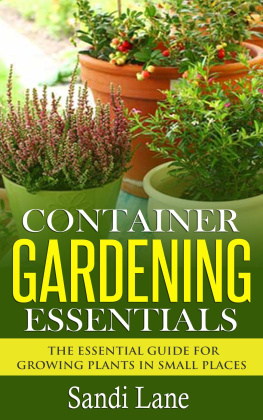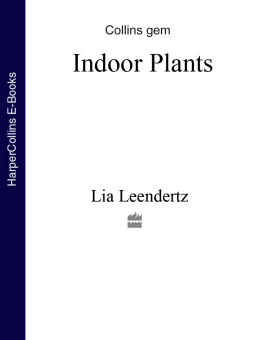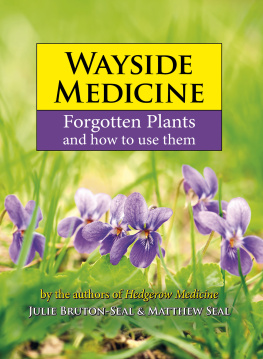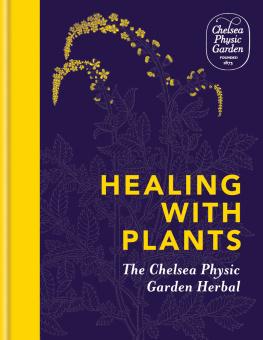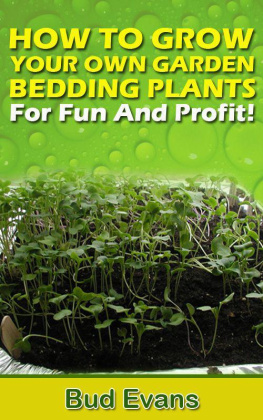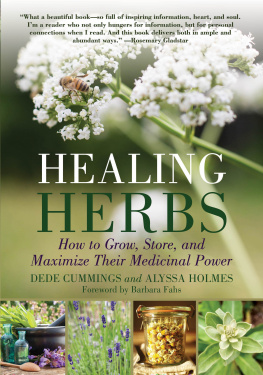Herbal Medicine Garden
Summer Wallace
Copyright 2020 Summer Wallace
All rights reserved.
Index
Introduction
I would like to thank you for choosing this book, and I hope that you find it informative and helpful. Deciding to grow herbs for medicinal purposes is a smart step to take for your health. It is also a decision that your body will thank you for.
The book is broken into four parts. In the first part, we are going to go over the basics of herbal medicine. This will look at what herbal medicine is and then go through a quick introduction into medicinal herbs.
In the second part, we will go over how to create an herb garden. Well go over how to create a garden in whatever space you have. Whether you live in an apartment or you have a small backyard, you can have a garden. Well also discuss what you will need to grow your plants. This will include the types of soil it needs, along with the amount of water and sunlight they will need. Well also look at the tools you should have on hand to make your gardening easier.
The third part will go over all of the herbs that you should think about growing in your garden. You may be surprised by some of these plants, considering many of them have been labeled as weeds.
In the fourth part, we will go over different ways to use your herbs. First, well talk about how to prepare your herbs for use. Then we will look at how to make herbal infusions, essential oils, lotions, and salves.
Herbs were on this planet long before modern medicine was. Some believe that there is a plant for every disease. Keeping your own medicine garden is a great way to care for yourself, keep yourself healthy, and make sure youre ready for any unforeseen illness. Plus, you have the added benefit of having delicious herbs on hand whenever a recipe calls for it.
Before we jump into the information you came here for, lets go over the medical disclaimers.
The use of herbs and plants for medicine should not replace the advice of a doctor and modern medicine. If you have a serious medical condition that you are taking medicine for, do not discontinue use of the medicine. Herbs should only be used as a supplement or a preventative measure, and should never be used to replace regular medical care. The choice to use these herbs as medicine is up to you. I am here only to supply some information. I am not a doctor, so the information within this book is simply information and should not be seen as medical advice. Always consult with your doctor before starting an herbal regimen, especially if you are already on prescribed medication.
Part 1: Herbal Medicine
Chapter 1: What Is Herbal Medicine
Herbal medicine, which is also known as herbalism, is the study of botany and using medicinal plants. Plants have long been the basis for medicine through most of history, and because of this, it is still widely practiced. Our modern medicine also using many plant-derived compounds to create a basis for evidence-based pharmaceutical drugs. Some forms of herbal medicine will also include the use of bee and fungal products, as well as animal parts, minerals, and shells.
Herbal medicine is also sometimes referred to as paraherbalism, phytomedicine, or phytotherapy. This describes alternative practices that use unrefined plant extracts as health-promoting agents or medicines. Herbal dietary supplements tend to be categorized under the phytotherapy category.
There is archaeological evidence that shows that the use of medicinal plants dates all the way back to the Paleolithic Era, around 60,000 years ago. Written proof of herbal medicine dates back around 5,000 years ago to the Sumerians. Some ancient cultures wrote about plants and their medicinal uses in books that they referred to as herbals. The ancient Egyptians wrote about herbs in their medical papyri, drew illustrations of them in tombs, and in rare instances, there have been medical jars containing trace amounts of herbs. One of the lengthiest, oldest, and most important papyri in Egypt is the Eber Papyrus. It dates to around 1550 BCE and goes over more than 700 compounds, which are mainly plants.
One of the earliest known Greek herbals was written by Theophrastus of Eresos in the 4 th century BCE. He wrote Historia Plantarum . Only a couple of fragments of these writings have survived the years, but what does remain, scholars have found overlap significantly with the Egyptian herbals.
Seeds, which they probably used for herbalism, have been found in archaeological sites of Chinas Bronze Age dating from around the Shang Dynasty. 224 compounds are talked about in the Huangdi Neijing , which is an early Chinese medical text, and around 100 of those compounds were herbs.
Herbs are a very common feature in ancient Indias traditional medicine, where their main treatment system for diseases was diet. Pedanius Dioscorides, a Greek physician, botanist, and pharmacologist, wrote De Materia Medica and is one of the best examples of herbal texts, which was used for 1500 years until around the 1600s.
There are many different types of herbal forms which can be administered; the most common is a liquid form that the patient drinks, which is normally a tea, but can be a diluted plant extract. Herbal teas are created through extract herbs into water, but they can be made in many different ways. Infusions use hot water to extract herbs, like mint or chamomile, through steeping. Decoctions are where herbs are boiled for a long time and usually use harder substances, like bark or roots. Maceration is a cold infusion of plants that have a high mucilage content, like thyme or sage. To make macerates, plants get chopped up and then added to cold water. They are left there for seven to 12 hours.
Tinctures are created with alcohol, and they are stronger than teas. Tinctures tend to be made by combining 100% pure ethanol and herb. The finished product normally has an ethanol percentage of around 25%, but can be up to 90%. You can make non-alcoholic tinctures with glycerin, but they are believed to not be as easily absorbed by the body as alcohol tinctures.
Herbs can also be applied topically. Essential oil extracts can be rubbed onto the skin once diluted in a carrier oil. Lotions, creams, balms, oils, and salves are other types of topical application. Most topical applications are made from oil extractions. You can take a food-grade oil and soak herbs in it for a week to a month to allow its phytochemicals to be extracted into the oil. Then the oil is used to make lotions, creams, or salves.
Chapter 2: Intro Into Medicinal Herbs
A medicinal herb is a plant that is used for medicinal purposes. There are also aromatic herbs that are used to add fragrance and culinary herbs that are used to flavor foods. Most medicinal herbs are used as culinary and aromatic herbs as well. Medicinal herbs tend to cover a wider range of plant life. They could be perennials or annuals, herbaceous or woody, shade requiring or sun-loving. The plant parts that get used for medicine may be their bark, seeds, roots, flowers, or leaves. The one thing that groups medicinal herbs is their healing properties. Since plants have a long history of medicinal use, there is a lot of folklore associated with them.
The word herb use to only apply to any non-woody plants, including some shrubs and trees. Nowadays, the word herb is used to refer to any part of the plant like the roots, stigma, leaf, flower, bark, stem, seed, or fruit, as well as any non-woody plant. These medicinal plants get used for perfume, flavonoid, or food, as well as for medicine and spiritual activities.



